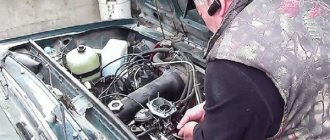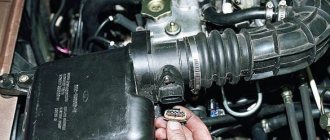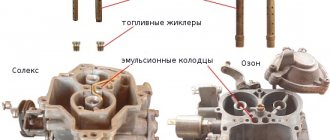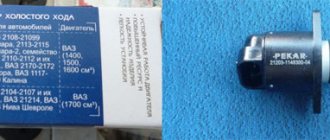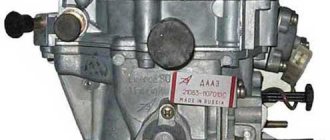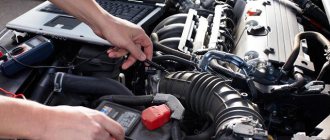I’ll share a little experience, in case it’s useful to someone)
I recently encountered this problem - I mean, I’m driving, I’m driving, I put it in neutral at a traffic light (or I’m squeezing the clutch), and my revs start to drop, the car practically stalls. This bullshit bothered me for quite a long time. That is, then no, then no again) In short, periodically my brain began to float. And then the singles disappeared completely. That's all! At least shit yourself. Whatever I tried, I couldn’t find the reason. Well, I think that's it, turn off the lights. We've arrived.
It's all up to chance, so to speak) I don't know why the hell I removed the terminal from the idle speed sensor, but when I put it back on, I noticed an interesting concept)) If I touch the contact on the sensor with the tip of the terminal, the idle ones appear, and if I put the terminal on, then disappear.
SHAITAN. Well, that's how it is! How the fuck?! In short, I pressed the contact, and everything worked again) Now, when some kind of crap starts with the electrics, I first move all the contacts))) What an adventure))
And also, I don’t know, whether it’s on the website or not, here’s a way to check the sensor: minus from the battery to the sensor body, plus to the sensor contact. If you hear a click, it works) If there is no click, replace it. And I think I even heard that it is better to buy a sensor with a red rubber band, and not with a black one. Better quality. But I don’t know for sure, I haven’t tried) So far the old one is shy)
The VAZ 2107 is not the best model among cars in its class when compared with foreign equivalents. However, thanks to its low price and accessible service, the car has been popular throughout the post-Soviet territory for many years. The car was produced from 1982 until 2014. That is, the oldest model is more than 30 years old. During such a period of operation, the owner will be able to encounter all types of faults and investigate most of the causes of problems.
After several years of operation, the VAZ 2107, as well as the almost identical model 2105, begins to show a new character with changes not for the better. Malfunctions associated with the power unit and its body kit are of a different nature, but are symptomatic:
- the engine stalls periodically;
- does not maintain stable speed;
- unstable operation at idle;
- hard to start;
- insufficient power;
- increased fuel consumption.
All malfunctions appear for two reasons: violation of adjustments or wear of parts.
Unstable operation of the injection engine
Usually expressed in a spontaneous change in engine speed. Observed while driving and at idle. The most common reason for low speed in VAZ2107/2105 injection units is the failure of the mass air flow sensor (mass air flow sensor).
This device controls the amount of air entering the engine. Based on this data, the ECU regulates the supply of a combustible mixture with the optimal fuel-to-air ratio under different engine operating modes. Accordingly, in the absence of this balance, engine speed begins to depend on the amount of incoming oxygen. That is, the wind blew - the speed increased, the speed died down - it decreased.
It is quite simple to make sure that it is the mass air flow sensor that is faulty. Disconnect the device connector and the ECU will switch to emergency mode. In this mode, fuel supply is controlled by the throttle position. If the car begins to behave more adequately, then the MVR is faulty. You can drive like this, but the power will drop slightly and fuel consumption will increase.
A failed mass air flow sensor cannot be repaired, except for contamination, so you can try to clean it.
Cleaning algorithm for DMVR VAZ2107/2105:
- Remove the sensor along with the protective casing.
- Unscrew the two screws and pull the sensor out of the base without touching the surfaces of the active element (straight, bent wire).
- Wash the casing with any dishwashing liquid.
- Using a bottle of cleaner for DMVR or for carburetor, based on alcohols (without acetone), carefully clean the surfaces.
- Pour generously 3-4 times, the liquid should drain.
- Dry the device.
- Reassemble the block in reverse order.
If the problem persists, you will have to buy a new device.
We go to the service station for service
Using low-quality fuel can also lead to serious engine damage. This may not only be problems with the fuel filter, but also general contamination of the injection system.
It should be said that such a breakdown can only be determined after computer diagnostics. Such diagnostics will allow you to identify existing problems with the injectors, after which it is necessary to replace failed spare parts under service conditions.
We would not recommend changing the injectors yourself. This kind of work is complex and can only be done by experienced workshop technicians on modern cars.
In some cases, the reason why the engine does not pick up speed and there are operational problems is the failure of the control unit. The engine's computer brains send the engine the wrong signals, causing the engine to shake and the engine to run rough.
Such a breakdown can also be determined only after computer diagnostics. Depending on the nature of the problem, it is necessary to either reprogram the control unit or replace it. In the latter case, the cost of repair work can be quite high, since such engine brains are expensive.
Retarded ignition is also a common reason why an engine runs rough. If the engine does not pick up speed, there is a pronounced shudder, the cause of the problem in this case may be late ignition. The fuel mixture entering the cylinders is simply not completely burned and continues to burn in the exhaust manifold.
As a result, the power unit operates unevenly, noticeable detonations appear, the engine runs intermittently, and the existing engine control unit begins to forcibly reduce engine speed.
Unstable operation of the carburetor engine
The nature of the unstable speed of the VAZ2107/2105 engine with carburetors is the same as that of an injection engine, in the uncontrolled supply of air or fuel into the combustion chamber.
But in this case, the carburetor is responsible for preparing the combustible mixture. This is a completely mechanical device that is responsible for the optimal ratio of fuel to oxygen for different operating modes of the power unit.
Despite the fact that there are filters at the fuel and air inlets, they may not work efficiently, usually due to a long service life exceeding that specified in the maintenance standards. As a result, the carburetor jets become clogged with small particles.
Drivers with great experience do not stand on ceremony, they throw the VAZ2107/2105 carburetor into a bucket of gasoline for a day, then blow it out from all sides with compressed air and the carburetor seems to work normally. This is a normal solution, but flammable. Among the causes of engine malfunctions that are caused by carburetor failure are:
- displacement of the position of the adjusting screws due to shock or vibration;
- increase in the diameter of the jet holes due to wear;
- wear of the damper axis, limiting its travel;
- clogging of jets;
- failure of the float seal.
To determine the malfunction of the VAZ2107/2105 carburetor, and it will most likely be complex, start by checking the tightness of the float. To do this, remove it from the top carburetor cover (it needs to be removed). If there is gasoline in the float, throw away the float; if there is air, check in a bowl of water for bubbles. Let's say it passed the exam, then it is necessary to check the gap.
Lift the carburetor cover vertically. The gap between the float chamber and the carburetor wall should be 6.5 mm.
Install the carburetor cap and run the engine for 30 seconds. Remove the cover. The gasoline level should exactly coincide with the middle of the conical surface of the carburetor body. If this does not work, you should slightly bend the corner of the float rod.
Over time, air and fuel jets either become clogged or wear out. In the first case, they need to be cleaned and blown out. In the second case, you should check the throughput of the jets using a tank of water installed above the measured jet by 1 meter. They are connected by a tube. A volumetric flask is installed below. Measurements take place in units of cm3/min. Depending on the marking of the nozzle, the volume of liquid collected per minute in a volumetric flask should correspond.
It is much easier after 7-10 years of carburetor operation to buy a set of jets and replace them.
Those who use gas installations should know that a carburetor is not used when driving on gas. Over time, oxide forms inside dry jets, which clogs the fuel supply holes. A gasoline car may not start. It is recommended to use gasoline periodically.
Malfunctions and their elimination
Violation of the idle speed may indicate dirt getting into the fuel nozzle
. It is best to clean the jets with compressed air, for which you need to remove them and blow out the fuel supply channels. Also, the stability of the engine can be affected by disturbances in the power supply system from the vehicle’s on-board network to the solenoid valve. The wiring can be checked for serviceability using a tester or a simple “control” - a light bulb with two wires. Fuel overdose
which enters the carburetor chamber is caused by damage to the seal of the float in the gasoline supply mechanism. It can be eliminated by replacing both the float needle itself and the seat to which it is connected. After the operation to replace and repair the feed mechanism, it must be adjusted.
Violation of the parameters of the gaps between the contact pads of the breaker leads to a failure in the stability of engine speed. When the gap decreases below the standard value, which is 0.4 mm, an excess spark is formed, and when the gap increases, an insufficient spark is formed.
Article on the topic “Do-it-yourself modification of 2107.”
Setting the required clearance, as well as replacing the breaker bearing, will stabilize the speed. Play in the bearing is formed due to operational wear. This may be caused by a hidden manufacturing defect.
The energy content of the spark can be affected by the loss of the resistance characteristics of the resistor, which is installed on the slider. A resistor breakdown on the road is an unpleasant situation, but easily and quickly corrected
. Experienced drivers are familiar with this carburetor disease and always have a piece of thin steel wire in their repair kit.
In order to get to the place where you can replace the resistor, it is enough to wrap the legs of the failed resistor with such wire. The main thing is not to forget to change the resistor afterwards.
Carburetor adjustment
Adjusting the carburetor involves several steps:
- Adjust the position of the float as described above.
- Check and set the “quality” and “quantity” screws to the initial state. Screw them all the way and unscrew them 2-3 turns for the “quality” screw and 3-4 for the “quantity” screw.
- Connect a tachometer or auto tester to the “K” terminal of the ignition coil, and the second probe to the housing.
- Start and warm up the engine to a temperature of 90°C
- Use the “quality” screw to set the maximum idle speed. The gasoline supply increases when the screw is rotated counterclockwise.
- Use the “quantity” screw to set the speed higher, approximately 80-90 rpm.
- Using the quality screw, we determine whether these speeds are maximum; if not, then we repeat the procedure.
- If the position of the quantity screw does not affect engine speed, tighten the quality screw so that the speed drops by 800-900 rpm.
This carburetor adjustment may not be entirely accurate, but does not require special equipment.
If the car stalls
An engine that suddenly stops not only creates an inconvenient driving experience, but also poses a safety hazard to the driver and passengers. There are several reasons.
Stalls at idle:
Stalls while driving:
- interruption of fuel or air supply due to a dirty filter;
- fuel pump malfunction;
- clogged carburetor jets;
- engine overheating.
When diagnosing a car whose engine stalls in the most unexpected places, it is better to start by checking the idle speed sensor.
It's easy to check its functionality. Dismantle the device without removing the contacts, or connect them after dismantling. Hold the device in your hands, place your finger on the cone needle and ask a friend to turn on the ignition. If you feel shocks, then install the device back. The idle speed sensor is OK.
Not enough air
Often the car starts up well and runs on choke, but as soon as the choke is turned off, the engine stalls. This indicates only one thing - lack of air. Most likely the air jets are clogged. They need to be unscrewed and cleaned. Then check that the car should not stall without suction.
There are an incredible number of reasons for poor performance of car components with similar symptoms, but only a specialist with a set of professional diagnostic tools can figure them out. But if you feel confident in yourself, go for it, VAZ service centers are already waiting for you.
What to do if the idle speed of a VAZ 2107 jumps, is there any panacea for this? The fuel system causes a lot of trouble for owners, but one thing needs to be taken into account - it is not always to blame. For example, in carburetor engines with a classic ignition system, there is a high probability of contact group failure if there is instability in the idle speed. But with injection engines everything is somewhat simpler. And now about everything in more detail.
EPH sensor is faulty
The idle speed economizer or idle speed sensor is located under the hood of the VAZ 2107 and is screwed to the side of the carburetor. It is a small cylindrical electromagnet screwed into the unit. On the back side of the valve there is a contact, the wire from which goes to the power circuit of the ignition switch.
EPHH control unit: 1 — block outputs; 2 - body; 3 - printed circuit board with microelectronic elements.
If the carburetor cannot be adjusted in any way or the VAZ 2107 does not idle, and the idle speed disappears very quickly or the engine is unstable, then it makes sense to start the engine and try to unscrew the valve a little. If the operation of the carburetor engine is restored, tighten the valve with a little force and try changing the amount of mixture. In 90% of cases, the carburetor starts working correctly again.
Another case is complete valve failure. To do this, you need to check it. You need to connect it directly to the battery. If clicks are heard, then the valve is working. Try screwing it into the carburetor and starting the engine. If successful, you need to look for a break in the electrical wiring and then you won’t need to adjust xx.
Why is the engine speed unstable?
When it comes to the carburetor, there are several reasons:
- The carburetor is clogged, the movement of air and gasoline becomes impossible.
- The operation of the solenoid valve is disrupted - the winding is burned out or the nozzle is clogged.
- Fuel or air filters are clogged.
- Incorrect carburetor adjustments on VAZ 2107.
In most cases, the culprit is the solenoid valve. Its appearance is shown in the photo. It is necessary in the power system for the following purpose - it opens the fuel supply when the ignition is turned on and closes it when it is turned off. Consequently, the engine stops immediately after turning off the ignition.
The VAZ 2107 carburetor solenoid valve is a small device consisting of the following elements:
- Frame.
- Winding (one end connected to a metal body).
- A rod that acts as a valve that opens and closes the fuel supply at idle.
- Copper jet with holes. Please note that the jets are marked; there are several sizes.
The solenoid valve operates only when the ignition is on. If suddenly there is a break in the power circuit, you can temporarily connect the central wire of the device to the positive terminal of the battery. Just try to carry out repairs as soon as possible.
How to check the strainer
This is done as follows. Use manual fuel pumping and fill the float chamber with fuel, after which you will be able to see the shut-off valve close. Then move the top filter cover and remove the valve. It must be thoroughly washed in solvent, then dried using compressed air.
When the engine behaves incorrectly during loads, there are dips or loss of power, or the car “reacts poorly to the pedal,” most likely you have a problem with the fuel supply. In addition, often the cause is a faulty strainer.
Important! It is strictly forbidden to wipe the bottom of the float chamber using a fluffy or any other rag, since after such cleaning, invisible fibers may remain on the bottom of the chamber, which will clog your jets during operation.
The float chamber is cleaned using a rubber bulb and then dried with compressed air.
Preparing to adjust the idle speed
If you do not plan to clean and disassemble the VAZ 2107 carburetor, then one of the tools you will need is a screwdriver. A device for measuring the speed (tachometer) is installed in the dashboard. But it’s worth getting a mixture quality indicator. With its help you can create an air-fuel mixture in ideal proportions. This article will talk about adjustment using this device.
Before starting work, you need to warm up the engine to operating temperature. Let us remember that this is a temperature of about 90 degrees. You also need to put the air purification filter in place to simulate normal engine operation. Make sure the float is adjusted correctly. The fuel level in the chamber must always be stable.
There are also many requirements for ignition and gas distribution. Be sure that all clearances must be correct, and the ignition timing must be adjusted for the gasoline used. And most importantly, open the air damper completely while making the adjustment. That's all, the preparation work is briefly summarized, now you can begin the idle adjustment procedure.
Now let's look at how the carburetor works, ensuring the distribution of the fuel-air mixture:
- Acceleration pump.
- Econostat system.
- Maintains constant fuel level.
- Idle support.
- Support for engine starting and warming up.
- Jets (air and fuel), diffuser, VTS atomizer, well and emulsion tube are located in the main metering chamber.
The carburetor is adjusted after cleaning and assembly. Before you start disassembling and cleaning, I suggest you remember the main saying of any auto mechanic - “Don’t make a fuss while it’s quiet,” meaning that you shouldn’t get into a place where everything is in order or disassemble something that has nothing to do with the breakdown.
Setting the idle speed of the VAZ 2107
Carefully inspect the carburetor, there are several screws on it - the quality of the air-fuel mixture and quantity. It is with their help that we will now try to adjust the carburetor. Of course, not every driver has such a device as a gas analyzer. However, not everyone cares about the level of CO in the exhaust. For convenience, it is advisable to have a digital or dial tachometer. You can find how to connect it correctly in the corresponding article on our website.
So, start the engine and turn the quality screw. Listen to the engine, you need to stop at the moment when the crankshaft speed is at its maximum. After this, you begin to rotate the quantity screw and achieve a frequency of 1100. And the last step is to set the frequency to 800-900 using the quality screw. Please note that if necessary, the idle speed adjustment must be repeated.
What about the injector?
Everything is a little simpler here, since no adjustments are needed. The reason is that a smart on-board control system is responsible for everything. And specifically for idling - the regulator (IAC). Some may call it an idle speed sensor, but this concept is completely wrong. The fact is that there are two types of devices on injection cars - sensors (reading) and actuators. The idle air control is a stepper motor; it does not measure anything, but on the contrary, it opens and closes the air supply through a special channel.
A breakdown of the IAC can only be determined by external signs, and then only relatively. The fact is that the control lamp on the dashboard will not light up if the regulator suddenly fails. But if you feel unstable revolutions, or they have disappeared completely, and the engine jerks and stalls, then first of all, of course, it is worth checking the performance of the IAC. It is worth noting that sometimes the “Check” can light up when the IAC is faulty. This happens if the engine detonates. The knock sensor signals a malfunction to the electronic control unit.
The car starts and immediately stalls: causes and solutions to the problem
Owners of VAZ 2107, 2110, 2112, 2114, and other cars, may encounter a problem - the car starts and immediately stalls. The engine starts, but after a few seconds the speed drops and the engine stalls. Let's look at possible causes of startup failure and ways to eliminate them.
First, you need to go through the most obvious options.
- Gasoline (diesel fuel) has run out. No matter how paradoxical it may sound, drivers often forget to monitor the level of fuel in the tank.
- On diesel engines (especially in winter), the reason that the car starts and stalls almost immediately can be frozen fuel.
- The quality of gasoline at gas stations is often appalling, so if you fill your car with low-quality fuel, you may encounter the problem of a stalled engine. If there is only a little bad gasoline, you can dilute it with good gasoline. But if the tank is full, then it’s better to drain the surrogate out of harm’s way.
- Worn wires and old (faulty) spark plugs are also quite often the cause.
- Engine compression, or rather its absence, can provoke a situation in which the engine stalls barely having time to “catch up”. But this is already a very serious breakdown, the appearance of which is accompanied by a host of other symptoms, which are simply impossible not to notice during the operation of the car.
- The injector starts and stalls
- Why do carburetor cars start and stall?
- Other reasons for incorrect starting of the VAZ 2107 engine
- Adjusting the fuel level in the float chamber (Solex carburetors)
IAC breakdowns
If you have a VAZ 2107 with an injection engine, then pay due attention to the condition of the vehicle systems. If the speed on an injection engine fluctuates, then you need to look first at the idle speed control. The fact is that the breakdown of such a mechanism as the IAC can lead to very sad consequences, including a traffic accident. Here are the main signs by which you can independently determine whether the regulator is broken:
- The engine begins to “live its own life” - the crankshaft rotation speed is constantly changing, sometimes decreasing, sometimes increasing. Consequently, the tachometer needle constantly floats.
- When you start a cold engine, the crankshaft speed does not increase, it fluctuates within a certain range.
- If you turn on powerful electrical appliances (for example, a car radio, low or high beam), the speed decreases and does not return to the set level.
- When you engage the neutral gear, the engine begins to stall if you do not apply the gas pedal from time to time.
These are the main signs that the regulator is faulty. In fact, any interruptions in the idle level are the first sign of a breakdown or minor defect in the IAC. But the time has come to diagnose it. It won't be difficult to do this.
Carrying out diagnostics
The simplest method is to measure the voltage at the block to which the regulator is connected. These are terminals D and A. When the ignition is turned on, a voltage of 12 V should be present on them. If the voltage is less than this value, it is worth looking at the battery and generator. It is quite possible that the battery is undercharged. In the same case, if there is no voltage at all, it is necessary to check the entire power circuit of the device and diagnose the ECU.
Set the multimeter to resistance measurement mode. Between pairs of terminals A and B, C and D, there should be a resistance of approximately 53 ohms. Remove the IAC and connect (with the ignition off) to the block. Then turn on the ignition and look at the behavior of the needle - it should extend completely when voltage is applied. If this does not happen, we can judge that the IAC is broken.
Sometimes simply cleaning the regulator helps. To do this, you can use sprays, of which there are sufficient quantities in stores. But in some cases, only replacing the device will help. Of course, this is not a DAAZ carburetor, the cost of the IAC will be many times lower, and there will be no problems with replacement. If, even after the replacement, the engine does not idle, it is necessary to fully diagnose the injector.
